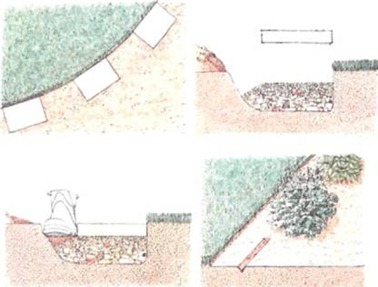





A really original feature heads the project work this week, as we edge our new circular lawn with one of the many decorative concrete paving slabs available. We select a slate-grey type from the many colours on the market. We start by edging the area where the cottage garden is going to be. Although getting late in the season, there’s just time to plant a last crop of quick-growing vegetables and to sow wallflower seed to flower next spring.
Needs list: 1 bag sharp sand; 10 pre-cast concrete paving slabs; 1 pkt wallflower seed; 1 pkt lettuce seed (or carrot or radish).
Time budget: 4 hours in 1 week
The gardener’s year is on the turn by now, though there’s still more summer to come. Most plants respond to the urge to form seed, fruit; some are already shedding their seeds. Shorter day length is noticeable, and dawn and dusk are definitely colder than a couple of weeks ago.
The wallflower is without doubt one of the world’s top ten old-fashioned favourite flowers. It’s been known and grown in European gardens since the Dark Ages, and is widely naturalised in many places. A quick look at wallflowers growing wild gives you a good idea of the sort of conditions they need in your garden : you’ll nearly always find them growing on cliffs or in the mortar of old walls. So their first need is perfect drainage. They also enjoy chalk or lime – but it’s not necessary to add any if you have an acid soil. They’re biennials, growing to sturdy little plants in their first year, then flowering, seeding and dying their second. Grown for their scent as much as their lovely velvety flowers.
1. Time to harvest dwarf French or bush snap beans. When the beans are shelled, save the young pods. Dice into a little salted boiling water, cover, cook 1/4 hour, strain; keep the liquid for your own white sauce recipe.
2. Make notes of any plants you see in the neighbourhood which take your fancy. Classify them into the kinds illustrated opposite. Find out the name whenever possible.
3. Water plants badly affected by drought. Pay particular attention to newly planted plants and to plants growing in containers. Plants growing in containers need feeding too. Use a proprietary liquid feed : get advice on what’s best from your garden centre. Keep a very special watch on seedlings. They arc the most vulnerable to drought. Water before they wilt, but never keep too wet. Continue learning about your garden friends and foes. If you find a toad in your garden, don’t scream. It’s a friend, one of the greatest of all enemy insect eaters. Make sure you don’t disturb its lair: keep it cool, protected and sheltered. Don’t handle the toad unnecessarily.

Now for the really smart bit about your lawn. Edging it with concrete paving slabs. First, check the exact diameter of your lawn. Go back to Stage 8 and go through the same measuring process again. Position slabs where you want them, 18 in. apart. Admire the effect. Mark position of each slab, then stack out of the way. Dig holes bigger than the slabs, at least 6 in. deep. Fill with brick/stones/rubble. Make firm. Cover with 1/2 in. layer builder’s sand. Bed slabs on that. Set them just below the grass level so that your mower will clear them. Back fill and ram soil firm. Adjust slab levels with extra sand. Sow wallflower seed in drills: transplant later.
A plant is a plant is a plant but. It does help your gardening if you can recognize the basic types.
Let’s start with an annual. Little things, fast growing, from seed, to flower to seed and dead in a season. Cheap, but often self-seed in your garden.
A biennial takes 2 seasons to do the same thing.
A perennial has permanent roots and makes top-growth annually, dying back each winter.
A bulb is a special type of perennial which stores its food over winter in a swollen underground bud – the bulb. Usually inexpensive. Often in flower when few other plants are, e.g., early spring, late fall.
Shrubs technically woody perennials, get bigger year by year. A good investment. Choose carefully: they last a lifetime.
Two Hour Gardening Project: Stage 26 Climbing Plants and Pergolas
Two Hour Gardening Project: Stage 25 Getting To Know Your Garden
Two Hour Gardening Project: Stage 24 Propagation and Growing Herbs
Two Hour Gardening Project: Stage 23 Principles of Pruning
Two Hour Gardening Project: Stage 19 Helleborus Niger and Bug Hunting
Two Hour Gardening Project: Stage 18 Choosing Shrubs for the Garden
Copyright © www.100flowers.win Botanic Garden All Rights Reserved